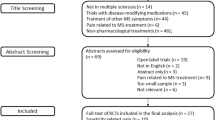Abstract
Oxcarbazepine (OXC) is an anitepileptic medication recently approved as monotherapy for partial onset seizure and demonstrated to be useful in the treatment of several neuropathic pain. We performed an open-label pilot study of OXC (dosage 600–1200 mg/day) in 12 multiple sclerosis (MS) patients suffering painful paroxysmal symptoms. Eight subjects were female and 4 male, with a mean age of 43.6 years, mean disease duration of 7.3 years and mean score at the EDSS of 3.2. Ten patients had a relapsing-remitting disease course, 1 had secondary progressive and 1 had primary progressive course. Painful paroxysmal symptoms (PPS) were defined as transient painful symptoms in any area of the body, with abrupt onset, brief duration, from a few seconds to a few minutes, with repetitive and stereotyped features. The subjective level of the PPS was scored using a three-point scale (0–3). The mean dosage of OXC was 1033 mg daily. Nine patients experienced a complete and sustained recovery within 1 month from treatment initiation (T0 vs. T1, p>0.05). Two patients dropped out of the study due to adverse effects: 1 case of nausea and dizziness, 1 case of C. hyponatraemia. The medication was well tolerated in the majority of the subjects. The study results provide a new possibility for treating painful symptoms in MS, but efficacy on PPS must be confirmed in a larger study.
Similar content being viewed by others
References
Wellington K, Goa KL (2001) Oxcarbazepine: an update of its efficacy in the management of epilepsy. CNS Drugs 15:137–163. Review
Carrazana E, Mikoshiba I (2003) Rationale and evidence for the use of oxcarbazepine in neuropathic pain. J Pain Symptom Manage 25[5 Suppl]:S31–S35
Zakrzewska JM, Patsalos PN (1989) Oxcarbazepine: a new drug in the management of intractable trigeminal neuralgia. J Neurol Neurosurg Psychiatry 52:472–476
Dogra S, Beydoun S, Mazzola J et al (2005) Oxcarbazepine in painful diabetic neuropathy: a randomized, placebo-controlled study. Eur J Pain 9:543–554
Criscuolo S, Auletta C, Lippi S et al (2005) Oxcarbazepine monotherapy in postherpetic neuralgia unresponsive to carbamazepine and gabapentin. Acta Neurol Scand 111:229–232
Solaro C, Brichetto G, Amato MP et al; PaIMS Study Group (2004) The prevalence of pain in multiple sclerosis: a multicenter cross-sectional study. Neurology 63:919–921
Solaro C, Lunardi GL, Capello E et al (1998) An open-label trial of gabapentin treatment of paroxysmal symptoms in multiple sclerosis patients. Neurology 51:609–611
Solaro C, Brichetto G, Battaglia MA et al (2005) Antiepileptic medications in multiple sclerosis: adverse effects in a threeyear follow-up study. Neurol Sci 25:307–310
Author information
Authors and Affiliations
Corresponding author
Rights and permissions
About this article
Cite this article
Solaro, C., Restivo, D., Mancardi, G.L. et al. Oxcarbazepine for treating paroxysmal painful symptoms in multiple sclerosis: a pilot study. Neurol Sci 28, 156–158 (2007). https://doi.org/10.1007/s10072-007-0811-3
Received:
Accepted:
Published:
Issue Date:
DOI: https://doi.org/10.1007/s10072-007-0811-3



